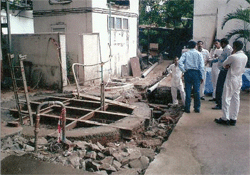Rain Water Harvesting Projects - Cipla
Sustainability :
It is observed that, in every monsoon the flooding at company premises get avoided due to rain water harvesting and also the newly found well has water upto minimum 10'0" depth inside the well in the month of May (i.e. before monsoon)
Scope of Replication :
The area facing problems like flooding situation like 26 th July 2OO5, flooding of Mithi River, rain water harvesting turned out to be the best solution. The rain water harvesting has made Cipla completely self reliant and importantly avoid using scarce potable municipal water. This was replicated at Ramji Asha School at Ghatkopar prputually flooding area due to that school used to be closed. Now after harvesting they dont have any problem, on quontrary they are getting enough water to maintain cleanlynessin the school i.e for 3000 students in each shift i.e. for 6000 students.
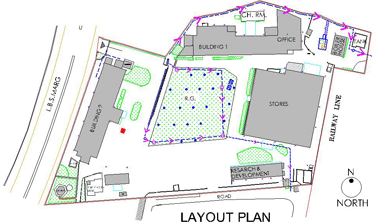

Work Implementation :
We worked out the master plan of rain water harvesting which is being executed in phases. At North-East corner, there were two bore wells, one dead 80'-0" & other 120'-0" deep yielding very less water. We decided to charge them with rain /storm water from road coming in to the company through main gate and also rain water falling in the company premises, in Phase 1
When we started the excavation around the dead bore wells, we found approx 12' - 0" dia old well below the existing P.C.C.; Well was opened, cleaned and excavated further to 20 ft. depth.(up to its original depth) This size takes care of one day average rain falling in the area.
At the said location of the well, we planned to harvest the rain water from the plot and charge the dead bore wells. The wall is termed as per pressure well too.
The monsoon water was taken through the storm water drain from North side through the filtration chamber consisting of sand, coal & Brick bats with lime and connected to the well. So that the cleaned / filtered water will be stored in the well & percolated in the landmass at the upper crest to form a upper level hydraulic cone. The existing live borewell (120'-0" deep) when surcharged charged the deeper hydraulic cone and the dry / dead Borewell 80' - 0" deep, when surcharged charged the increase mid level hydraulic cone, thus entire landmass at all levels was charged. Now the company gets more than 1,00,000 litre of water per day which is worth Rs. 35001- per day, i.e. Rs. 12,77,500/- per year and in future till the company exist.
Second Phase - It is proposed to percolate the water from surface areas of gardens to short bores were proposed in the central ground with perforated pipes at every 5 mtr. c/c upto 3 mtr. deep of 75 mm dia P.V.C. pipes with ring wells at the corner. Due to tremendous success of first phase, the water requirement was met with hence second phase is posponed.
Post Scenario :
Rain water harvesting is a charging system which charges the ring well / bore well with the help of rain water falling on the open spaces and also the water going on public area like road, footpath & railways. At our site, Cipla, we have collected the rain water falling on ground by providing storm water drain which was connected to filtration media (sand, coal and pebbles) and then to bore and existing well to charge the deep water caverns. This also resulted in stopping the flooding situation at company premises and also flooding at railway lines
Cost Benefits :
By executing rain water harvesting system we not only yield more water but also decrease payments to be made to tanker water suppliers and also municipal corporation for water supply. The municipal water supply is decreasing day by day but at the same time the water charges are going higher day by day. In this condition the rain water harvesting is must.
Outputs & Outcomes :
Rain water harvesting means to understand the value of rain and to make optimum use of the rain water at the place, where it falls. This harvested water can be used for the secondary purpose i.e. for flushing, gardening, car washing etc. that much precious municipal water can be saved.
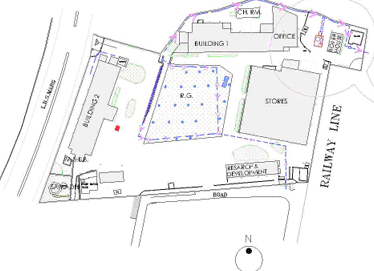

Sustainability :
It is observed that, in every monsoon the flooding at company premises get avoided due to rain water harvesting and also the newly found well has water upto minimum 10'0" depth inside the well in the month of May (i.e. before monsoon)
Scope of Replication :
The area facing problems like flooding situation like 26 th July 2OO5, flooding of Mithi River, rain water harvesting turned out to be the best solution. The rain water harvesting has made Cipla completely self reliant and importantly avoid using scarce potable municipal water. This was replicated at Ramji Asha School at Ghatkopar prputually flooding area due to that school used to be closed. Now after harvesting they dont have any problem, on quontrary they are getting enough water to maintain cleanlynessin the school i.e for 3000 students in each shift i.e. for 6000 students.
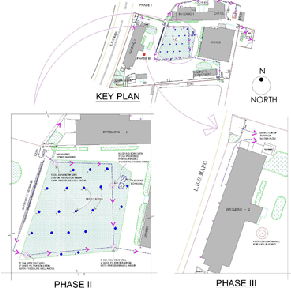
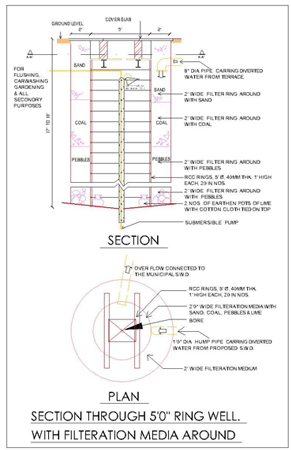
Existing two bores at north - east side corner
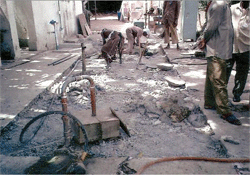
While Cleaning the well
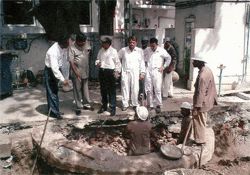
Storm water connected to well through filtration media
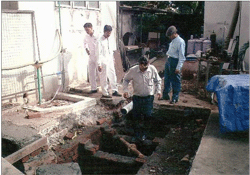
While Excavating an old well found
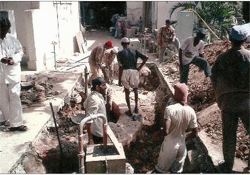
While cleaning the well
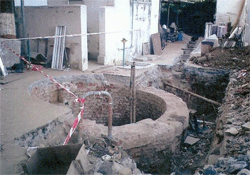
Under Completion
